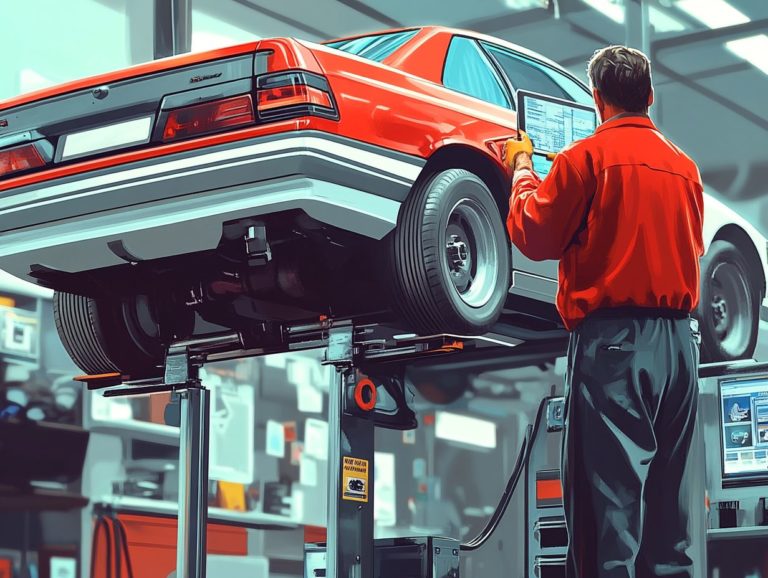How to Understand Your Vehicle’s Dashboard Lights?
Dashboard lights serve as your vehicle’s communication system, conveying crucial information about its health and performance. These lights can be confusing, but understanding them can save you time and money!
From alerting you to potential engine troubles to indicating low oil pressure, these lights often feel like a foreign language, leaving you uncertain about the appropriate actions to take.
Let s demystify the various symbols and colors you might encounter! This article clarifies the meanings behind common dashboard lights and offers essential guidance on how to respond when one lights up.
You’ll also find maintenance tips designed to help you prevent those bothersome warning lights from making an appearance in the first place. Understanding your dashboard lights is vital for safe and efficient driving, so dive in and equip yourself with this essential knowledge!
Contents
- Key Takeaways:
- Interpreting Dashboard Lights
- Common Dashboard Lights and Their Meanings
- What to Do When a Dashboard Light Comes On
- Preventing Dashboard Lights from Coming On
- Frequently Asked Questions
- What are the different dashboard lights on my vehicle and what do they mean?
- How do I know if one of my dashboard lights is a warning or just for information?
- What should I do if one of my dashboard lights turns on while I’m driving?
- What if I can’t find the meaning of a specific dashboard light in my owner’s manual?
- Do I need to take my vehicle to the dealership if a dashboard light turns on?
- Can I ignore dashboard lights and continue driving my vehicle?
Key Takeaways:
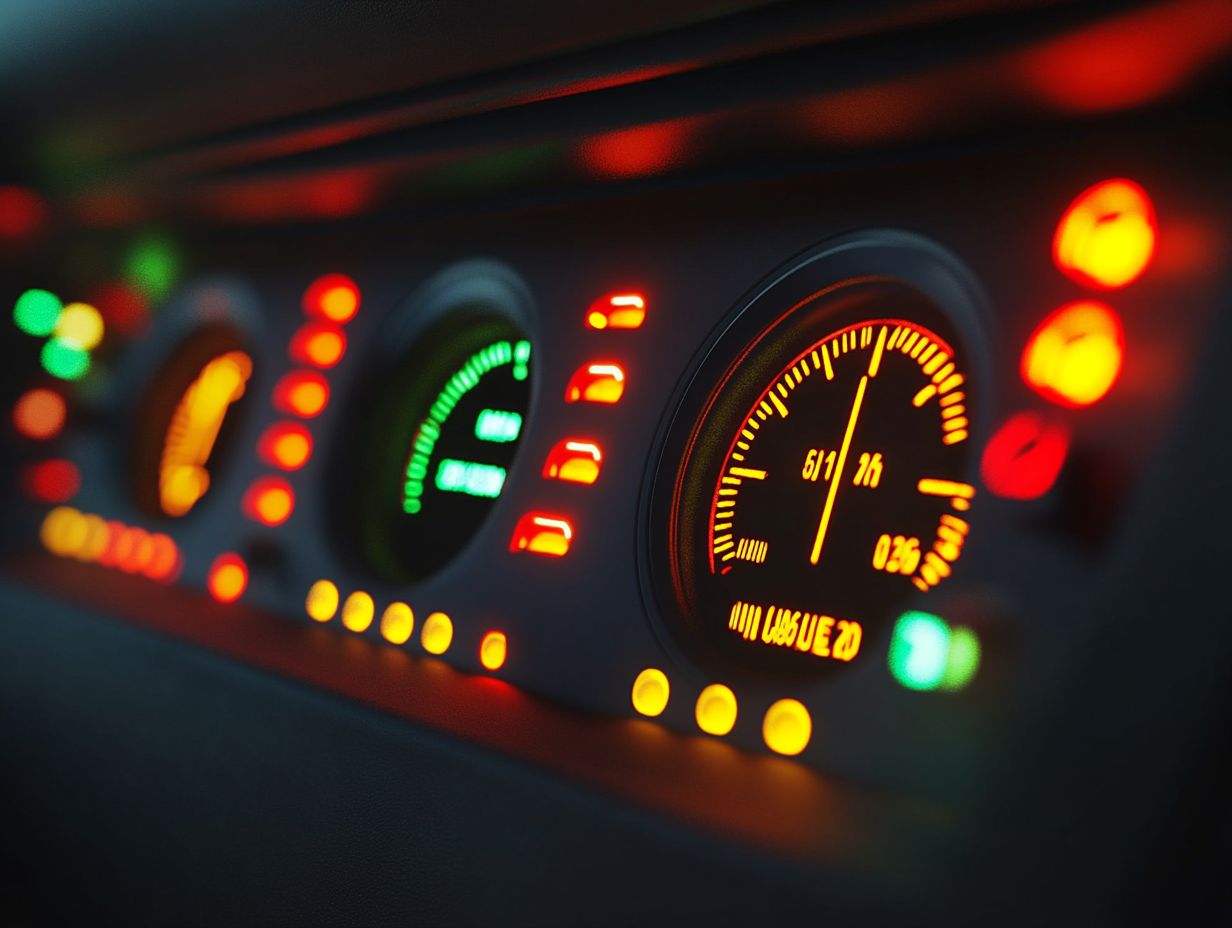
- Understanding your vehicle’s dashboard lights is crucial for your safety and the health of your car.
- Different symbols and colors indicate different issues, so it’s important to familiarize yourself with their meanings.
- Regular maintenance and immediate action when a light comes on can prevent costly repairs and keep your car running smoothly.
Importance of Dashboard Lights
Dashboard lights are your vehicle’s vital indicators, providing real-time alerts about its health, potential failures, and necessary maintenance.
Understanding these symbols like the check engine light, oil pressure warning, and battery alert is essential for your safety and optimal performance on the road.
Warning lights like the brake system alert and the tire pressure indicator are particularly important. When the brake system light activates, it signals potential issues that could compromise your braking efficiency, creating dangerous conditions.
The tire pressure warning light alerts you that your tire pressure is critically low, which can impair traction and fuel efficiency. Neglecting these warnings can lead to costly repairs and unsafe driving experiences, putting you and others on the road at risk.
Interpreting Dashboard Lights
Interpreting dashboard lights is crucial for effective vehicle management. These warning symbols offer valuable insights into your car’s operational status.
By familiarizing yourself with the meanings of various lights like the engine management light (which monitors engine performance) and the ABS light (Anti-lock Braking System light) you can enhance your safety on the road.
This knowledge ensures that your vehicle continues to run safely and efficiently.
Understanding Different Symbols and Colors
Understanding the various dashboard symbols and their associated colors is essential for your vehicle’s effective operation.
The color coding helps you gauge the urgency of each alert, making it easier to respond appropriately. These visual cues act as a quick reference, allowing you to prioritize your actions.
For example, a green symbol like the indicator for engaging cruise control signals that a system is active and functioning properly, reassuring you that all is well. On the other hand, blue symbols may denote less critical information, such as high beam headlights being activated.
By recognizing these levels of severity, you can make informed decisions about when to pull over for a quick inspection or when it s time to seek professional help, ensuring both your safety and your vehicle’s integrity.
Common Dashboard Lights and Their Meanings
Common dashboard lights, such as the engine warning light, battery warning light, and oil pressure warning light, are vital indicators of your vehicle’s health. Each light points to specific issues that need your attention.
For example, the engine warning light might indicate a malfunction in the engine’s management system. The battery alert may signal potential problems with the vehicle’s charging system.
Understanding what these lights mean is key to keeping your car running smoothly! Other important indicators include the low fuel indicator and tire pressure warning.
Engine Warning Light
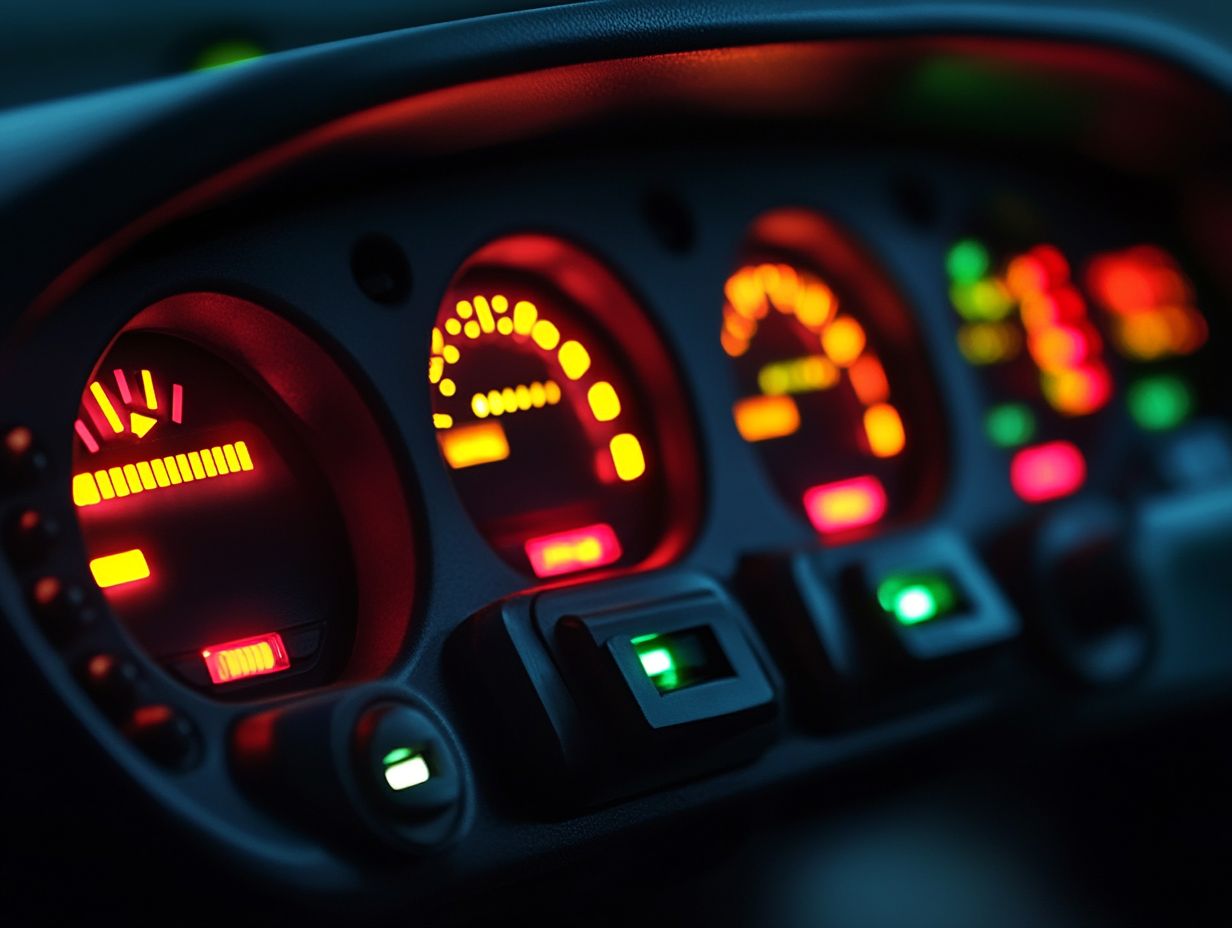
The engine warning light is one of the most critical indicators on your dashboard. It signals potential issues within your vehicle’s engine management system that need immediate attention.
When this light illuminates, it can mean anything from minor annoyances to serious engine troubles. It’s essential to perform a diagnostic check as soon as possible to uncover the underlying cause.
Common triggers for this light include sensor malfunctions, leading to inaccurate readings of vital components, or exhaust system issues that may impact emissions and performance.
To conduct a thorough check, start by using an OBD-II scanner, a device that reads error codes from your vehicle. These codes will provide valuable insights into areas needing attention.
Regular maintenance is key. Frequent check-ups can prevent small problems from becoming costly repairs. Consider setting maintenance reminders to ensure your engine performs at its best and extends your vehicle’s lifespan.
Battery Warning Light
The battery warning light serves as your vehicle’s early alert system. It indicates potential issues with the charging system, suggesting your battery may not be charging properly or that an electrical malfunction is happening.
Ignoring this warning could lead to complete battery failure. Address the issue promptly to ensure proper maintenance and prevent unexpected breakdowns.
Various causes may lead to this warning, such as a faulty alternator, worn-out battery connections, or corrosion. As a vehicle owner, performing routine checks on your charging system is essential. These small preventive measures can save you time, money, and frustration.
Regularly inspect your battery’s health and the alternator’s output to maintain overall reliability and safety. Prioritizing these straightforward maintenance tasks can significantly reduce the risk of sudden electrical issues.
Oil Pressure Warning Light
The oil pressure warning light is a vital indicator. It alerts you to potential issues with your engine’s lubrication system.
When this light illuminates, it often points to low oil pressure or concerns with oil quality. Giving this warning immediate attention is crucial; ignoring it could lead to severe engine damage due to overheating or insufficient lubrication.
This warning can stem from various issues, including oil leaks, low oil levels, or a failing oil pump. Regularly monitoring your oil levels and promptly addressing any leaks can help you avoid costly repairs in the future.
Preventive maintenance, like routine oil changes and inspections, is key to keeping your engine in optimal condition. By consistently checking your oil levels, you can prevent overheating and promote smoother engine performance.
This not only enhances longevity but also ensures your vehicle runs at its best.
What to Do When a Dashboard Light Comes On
When a dashboard light illuminates, it’s essential to take immediate and appropriate actions to ensure your safety and the vehicle’s performance.
Start by assessing the light’s color and symbol:
- Red lights typically signal urgent problems that require your immediate attention.
- Yellow lights indicate a need for caution.
Depending on the warning’s severity, safely pull over, consult your vehicle’s manual, or seek professional assistance if the issue persists. Don’t wait get your car checked today!
Immediate Actions to Take
Upon noticing a dashboard light, your first instinct should be to remain calm. If necessary, prioritize safety by pulling over to a secure location. It s essential to assess what the light means. For example, a red warning typically signals an urgent need for a diagnostic check, while a yellow light might allow you to make a brief assessment before heading to a service station.
If the engine warning light comes on, it often indicates a significant issue that deserves your immediate attention. In that case, you should turn off the engine and contact a mechanic. Conversely, a low fuel indicator generally just means it’s time to swing by the nearest gas station. You might be able to push it a little further if absolutely necessary.
Each light conveys crucial information about your vehicle’s status, guiding you on the appropriate steps to take. Understanding these nuances enhances your safety and can help prevent more serious vehicle damage down the road.
When to Seek Professional Help
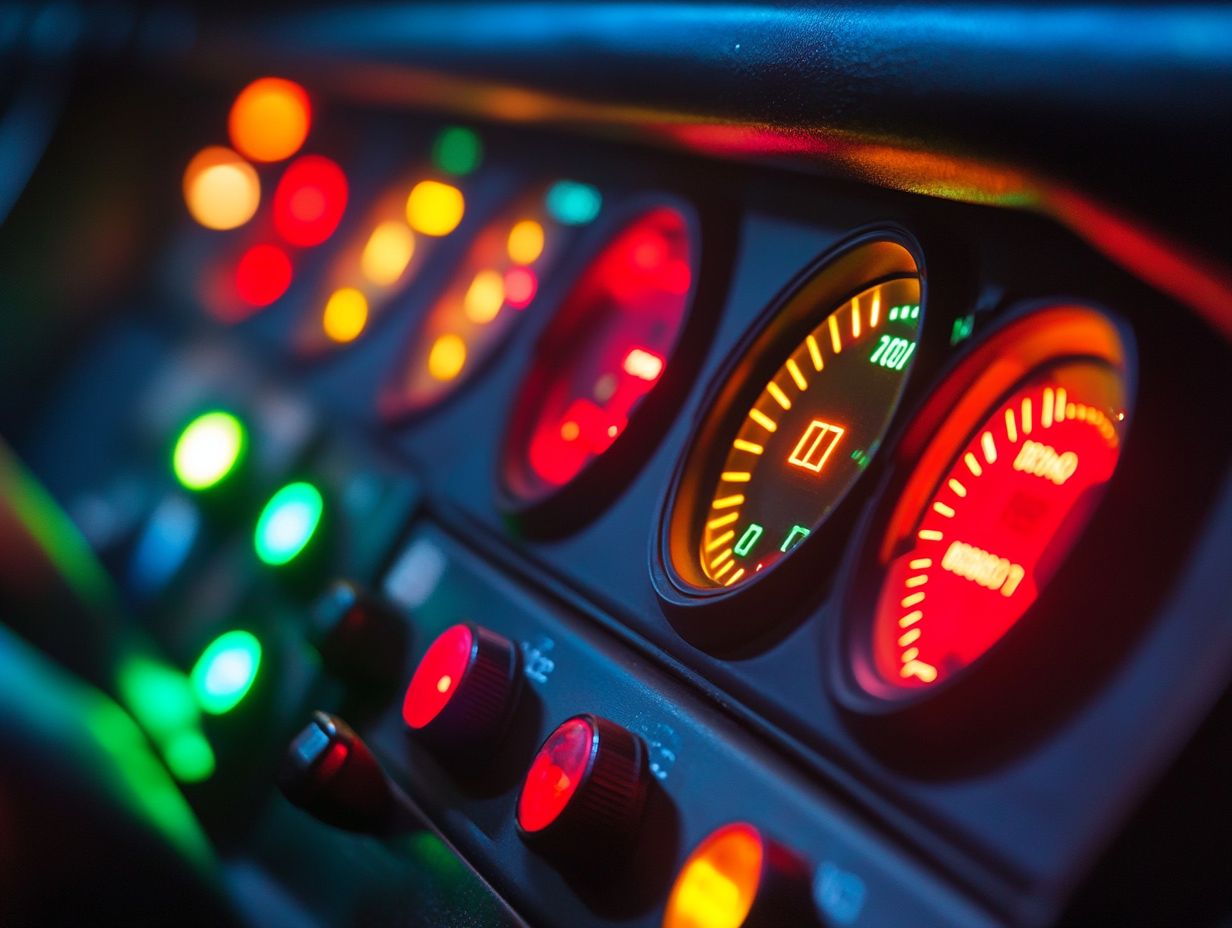
Knowing when to seek professional help after a dashboard light comes on is crucial for ensuring your vehicle’s safety and longevity. If a red light appears like the engine management light or oil pressure warning don t wait; consult a mechanic immediately. These often signal serious issues that, if ignored, could lead to costly repairs down the line.
Yellow or orange warnings should not be ignored either, such as the tire pressure monitor or check engine light. They often serve as early alerts that something might be off.
Regular maintenance reminders are a game-changer for your vehicle’s health. They highlight the importance of proactive checks like oil changes and tire rotations. By staying on top of these scheduled services, you can catch potential problems before they evolve into major repairs.
Ultimately, having a trusted mechanic and being vigilant about those dashboard indicators can significantly enhance your vehicle’s performance and reliability over time.
Preventing Dashboard Lights from Coming On
You can prevent those dashboard lights from illuminating by committing to regular maintenance and proactive vehicle checks. This ensures your vehicle stays in peak condition.
By adopting a routine that includes checking oil levels, assessing tire pressure, and monitoring fluid levels, you not only extend the lifespan of your vehicle but also enhance safety on the road.
This approach helps you address potential mechanical issues before they escalate into bigger problems.
Regular Maintenance and Checks
Regular maintenance and checks form the backbone of your vehicle’s reliability. They ensure that all systems function effectively, preventing pesky dashboard lights from popping up unexpectedly. Routine tasks like oil changes, brake checks, and tire rotations play a crucial role in maintaining your vehicle’s health and safety features.
By taking the time to schedule these essential services, you enhance performance and extend the lifespan of critical components. For example, check your oil every 3,000 miles to keep your engine lubricated. Timely oil changes fend off wear and tear, while regular brake inspections guarantee your safety on the road by addressing potential issues before they escalate.
Tire rotations, adjusted to your driving habits and conditions, encourage even wear. This prolongs tire life and boosts fuel efficiency.
Engaging in these preventive measures can save you from inconvenient breakdowns, costly repairs, and unwelcome surprises on the dashboard. This results in a smoother and safer driving experience.
Frequently Asked Questions
What are the different dashboard lights on my vehicle and what do they mean?
The dashboard lights on your vehicle serve as a way for your vehicle to communicate with you. Some of the most common dashboard lights include the check engine light, oil pressure light, battery light, and brake system light. Refer to your vehicle’s owner’s manual for a complete list of dashboard lights and their corresponding meanings.
How do I know if one of my dashboard lights is a warning or just for information?
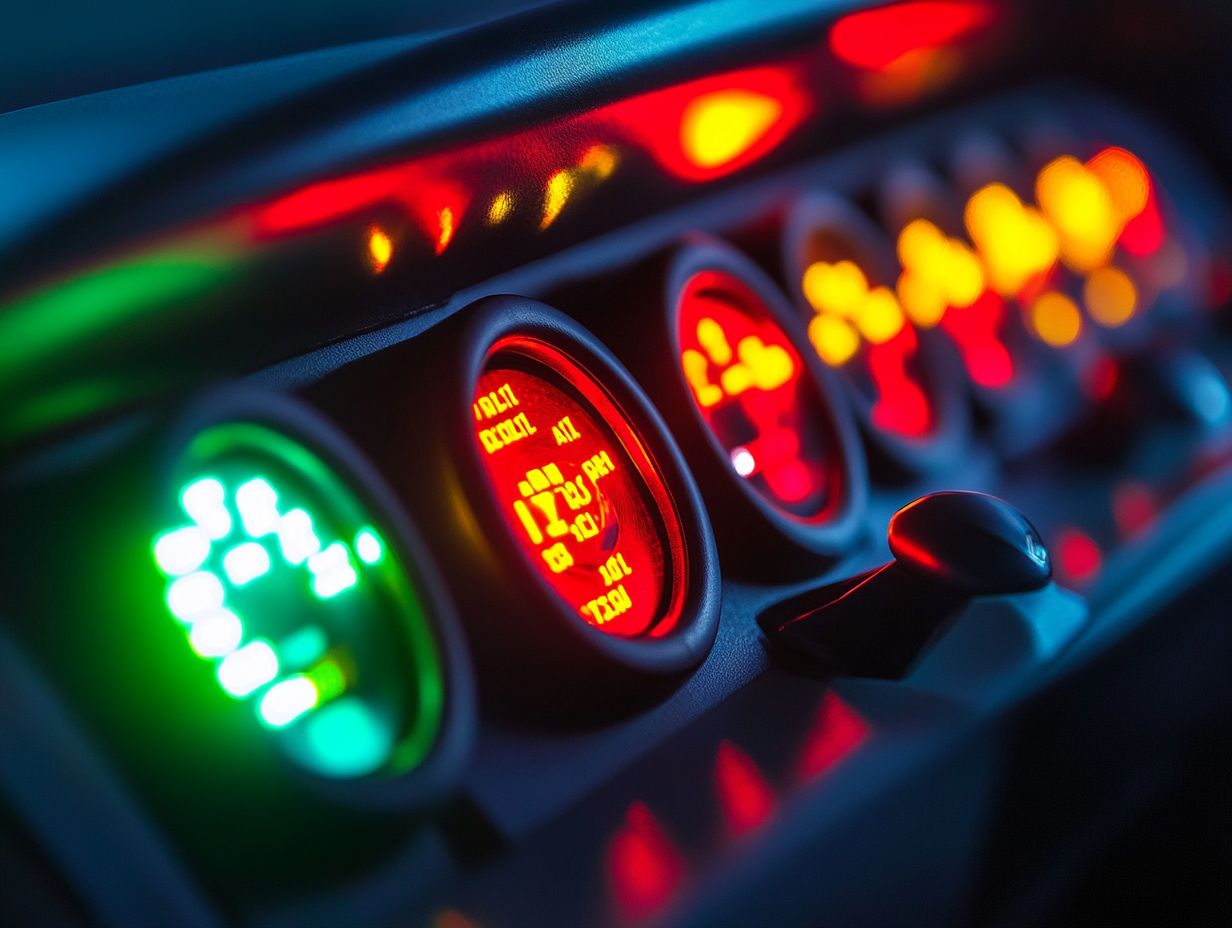
Warning lights are usually red or yellow. They may display the words “check” or “warning,” indicating a potential vehicle issue that needs immediate attention.
Information lights are typically blue or green. They provide helpful reminders or updates about your vehicle’s systems.
What should I do if one of my dashboard lights turns on while I’m driving?
If a warning light turns on, safely pull over and fix the problem. For example, the check engine light warns of potential issues that require immediate diagnosis and repair.
What if I can’t find the meaning of a specific dashboard light in my owner’s manual?
If you can t find a dashboard light’s meaning, consult a mechanic. They have the expertise to diagnose the issue accurately.
Do I need to take my vehicle to the dealership if a dashboard light turns on?
You don t always need to go to the dealership for dashboard lights. A local mechanic can often handle smaller issues.
However, if your vehicle is under warranty, take it to the dealership to avoid voiding the warranty.
Can I ignore dashboard lights and continue driving my vehicle?
Ignoring dashboard lights isn t recommended. These lights are crucial warnings that signal potential vehicle problems.
Addressing these issues promptly can save you from costly repairs in the future. Don t delay act fast!





